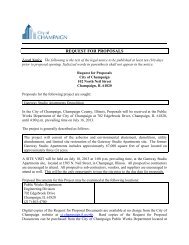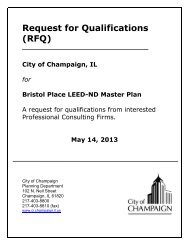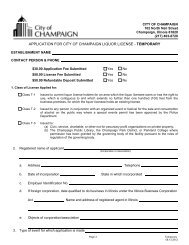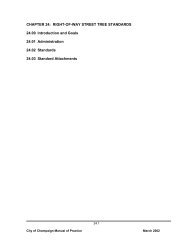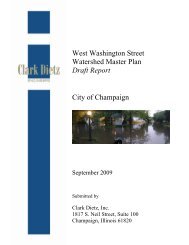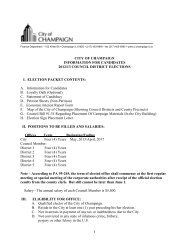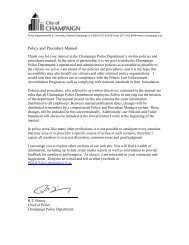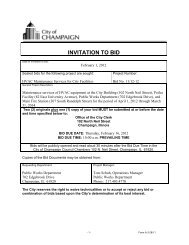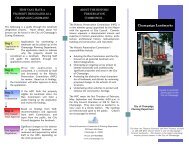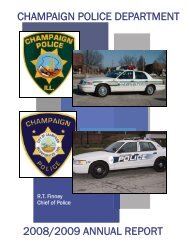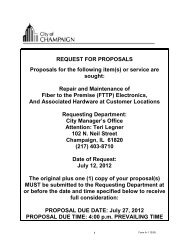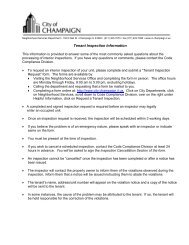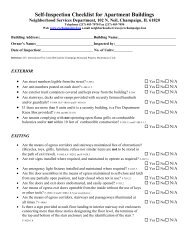2010-2014 Consolidated Plan - City of Champaign
2010-2014 Consolidated Plan - City of Champaign
2010-2014 Consolidated Plan - City of Champaign
You also want an ePaper? Increase the reach of your titles
YUMPU automatically turns print PDFs into web optimized ePapers that Google loves.
Strategies:a) Provide additional education to housing developers, architects, builders, <strong>City</strong>governments, and the general public about the importance and practicality <strong>of</strong> adoptinguniversal design standards to meet the growing need for more affordable, accessible homebuilding. Universal design features no-step entries, single-story floor plans, wider entry andhallways, reachable cabinetry and appliances, user-friendly doorknobs and handles, andaccommodations for grab bars and accessible bathrooms. The concept is to allow persons to livecomfortably throughout all stages <strong>of</strong> life and age in place without moving to a more accessible unit.Activities:1) Universal Design Guide: Create an inventory <strong>of</strong> accessible home designs using universal designprinciples and make the designs available to developers, architects and builders. Designs shouldvary to accommodate smaller lot sizes and character <strong>of</strong> existing neighborhoods, as well as thenewer subdivisions being constructed on the edges <strong>of</strong> the <strong>City</strong>.b) Expand affordable rental housing options for the physically disabled. Advocates for thedisabled population estimate that less than 5% <strong>of</strong> the housing stock is accessible. This supply isinsufficient for the existing disabled population and will prove to become increasingly inadequate as thepopulation continues to age.Activities:1) Inventory <strong>of</strong> Accessible Rental Units: Create an inventory <strong>of</strong> accessible rental housing options forthe disabled population and create a system for linking accessible units to persons that need them.2) Subsidized Accessible Housing: Identify additional Section 8 vouchers or public housing options forextremely low and low income disabled population.3) Developer Incentives: Provide tax incentives or fee waivers for developers to construct accessibleunits in multi-family housing developments, beyond what is required by the Americans withDisabilities Act.4) Home Accessibility Retr<strong>of</strong>it Program: 8-10 per year (40-50 for the 5-year period). Provide rehabassistance for property owners to make existing affordable units accessible for persons withdisabilities. This program is currently <strong>of</strong>fered by the <strong>City</strong> and is available to both owner-occupantsand renters. (FY 10/11 Budget: $60,000 CDBG)c) Preserve and expand homeownership opportunities for persons with disabilities. Personswith disabilities face two major difficulties in pursuing homeownership. The first is affordability, sincemany disabled persons live on fixed incomes that are well below the area median. Second, if they areable to afford to purchase, locating a unit that suits their individual needs is <strong>of</strong>ten impossible.Activities:1) Inventory <strong>of</strong> Accessible Owner Units: As noted in the strategy above, the creation <strong>of</strong> an inventory<strong>of</strong> accessible home purchase options for the disabled population would be very beneficial to thosewishing to purchase a home. This task could be accomplished by the Association <strong>of</strong> Realtorsworking in conjunction with an advocacy group such as PACE.2) Home Accessibility Retr<strong>of</strong>it Program: Provide financial and technical assistance to retr<strong>of</strong>it owneroccupiedunits for homebuyer with a disability and expand marketing efforts so that moreindividuals are aware <strong>of</strong> existing programs. (FY 10/11 Budget: $60,000 CDBG)Strategic <strong>Plan</strong>: Affordable Housing 81



